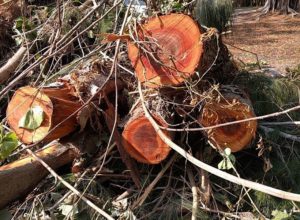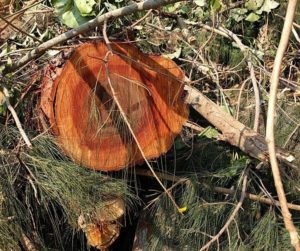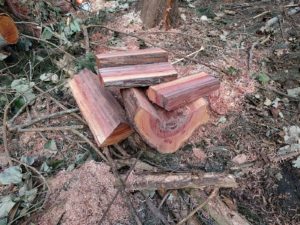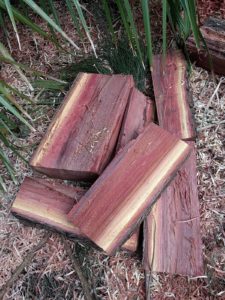Everything I am building these days uses local woods. I do not believe in, nor want to, cut down tropical forests to get things like rosewood. There are all sorts of wonderful woods to be had locally.
One of my favorites, and I have written about it before in this blog, is an invasive tree that was planted all over south Florida called Australian Pine here in Florida (it is not a pine). I know it as Casuarina (Casuarina equisetifolia). The wood is very hard, dense, takes a wonderful polish, and rings nicely when you tap on it. As good or better than any rosewood I think. I am down in Florida to check on my little house, after hurricane Irma. I took a drive around Jupiter Island, where there are quite a lot of big old casuarinas. I found that along Bridge Road (locals will know where that is) on some town land there was a whole stand of casuarina, part of which was uprooted. This is a different species of casuarina than I had cut before, though it looks very similar. I examined some leaf samples under magnification, and this stand was Casuarina glauca. This species tends to make dense exclusive stands from root suckers which makes this species particularly invasive. I spoke to a nice fellow in the town government, and he gave me permission to get some wood. When I got back out to the site the commercial tree people had already started the cleanup, and indeed were taking down the whole invasive grove. They had piled some larger trees up.
Can’t you just see the ukuleles in there? Can’t you just hear them?
I rented a large chain saw and went to work to cut some billets of wood. I cut quarter-sawn chunks, that will later be re-sawed into thin pieces to make backs, sides, and fingerboards. This is partially through the process:
This casuarina is a different color from what I had cut before. Previously most of the wood was dark purple-brown heartwood, with only a thin layer of cream colored sap wood along the outside. This wood seems to be three colors. A dark purple-brown heartwood, and pink-red intermediate layer and then the cream colored sap wood. I assume that this is because it is a different species of casuarina, Casuarina glauca. I don’t know if all trees of this species have these three colored bands, but I’ll pay attention in the future. If these colors hold up on drying there are some stunning instruments in there and I know they will sound great because of the density of the casuarina. Just look at those colors:
The only ‘bad’ part is that it will be a couple of years until this wood is re-sawn and dry enough that the first instruments will be available. Still, it is wonderful to have this stuff in the queue, and is a bit of a bright spot in the problems that hurricanes can bring. My thanks again to the Jupiter Island government for encouraging my wood habit.



